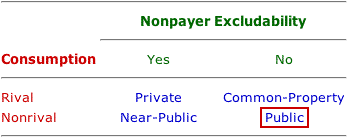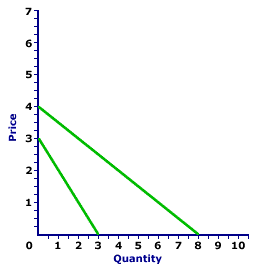Public goods are one of four types of goods differentiated by consumption rivalry (rival or nonrival) and nonpayer excludability (excludable and nonexcludable). In particular, these are goods characterized by nonrival consumption, meaning the consumption by one person does not impose an opportunity cost on others, and the inability to exclude nonpayers from gaining benefits from consumption.| Public Goods |  |
The exhibit to the right illustrates the four alternative types of goods -- private, public, common-property, and near-public -- based on the mix of consumption rivalry and nonpayer excludability. Public goods are in the lower left cell of the matrix, with nonrival consumption and the inability to exclude nonpayers.Public goods do not have well-defined property rights meaning they are, in essence, owned by everyone. But such "public" ownership is okay because every member of the public can benefit from simultaneously consuming the goods. This public or joint ownership of public goods means they cannot be exchanged through markets. The only efficient way to provide public goods is through governments. The prime example of a public good is national defense. Every member of society benefits when the country is protected from foreign attack and nonpayers can not be excluded from this protection. Other common public goods includes public health and environmental quality. Many, not all but many, of the services provided by governments (the "public" sector) fall in the category of public goods.
A prime reason that public goods must be provided by governments is the free-rider problem. The free-rider problem arises because people are able to enjoy the benefits of a good without paying. As such, they have no compelling reason to voluntarily pay for public goods as they have with private goods. This is a problem for the efficient allocation of resources.
Some Public Examples
The best place to go for examples of public goods is the public sector. And the best example of a public good is national defense. The other government functions also provide examples of public goods. An informed and education person provides benefits to all of society by being a better citizen, more productive worker, etc. A better transportation system improves the overall efficiency of the economy to the benefit of everyone. Improved public health and safety, including less crime, better environmental quality, and fewer diseases, also provides benefits to all members of society without the ability to excluded nonpayers.Nonrival Consumption
Because public goods are nonrival in consumption, the consumption by one person does not prevent the simultaneous consumption by others. Any number of people, potentially EVERYONE, can enjoy the benefits of consuming a public good AT THE SAME TIME. This means consuming a public good does NOT impose an opportunity cost on others.Suppose, for example, that Edgar Millbottom is protected from foreign invasion by the combined military forces of the United States government. The benefit that Edgar derives from this public good does not prevent others from also benefitting. Everyone residing in the country is protected from foreign invasion equally. More to the point, the protection extended to Edgar does exclude his friend Alicia Hyfield from protection, Edgar's consumption of national defense DOES NOT impose an opportunity cost on anyone else.
With nonrival consumption, efficiency is best achieved when everyone in society is allowed to consume the good, without restriction. Price is one restriction that might prevent consumption. According to the basic law of demand, the higher the price, the fewer the consumers. Because opportunity cost of consumption is zero, efficiency dictates that the price is also zero.
However, the opportunity cost of production is most certainly NOT zero. Resources, that could be used to produce other goods, are used for the production of public goods. The best (that is, efficient) way to finance the production and provision of public goods is through general tax revenue, taxes that are unrelated to consumption. This is just the sort of provision that governments are very good at doing.
Nonpayer Nonexcludability
Public goods are also characterized by the inability to exclude nonpayers from gaining ownership and control. As such, everyone in society can receive the benefits of consumption. No one can be excluded. In other words, public goods do not have well-defined property rights. Everyone owns a public good, meaning no one in particular can exert exclusive ownership and control.Again, let's turn to Edgar Millbottom's protection from foreign invasion. His friend and fellow citizen, Alicia Hyfield, cannot be excluded from also receiving the benefits of protection, even if she does not pay. Whether Alicia pays or not, she is protected. Whether Edgar pays or not, he is protected. Anyone, everyone, living in the country is protected and such protection cannot be withheld from nonpayers.
With nonpayer nonexcludability, public goods cannot be exchanged through markets. They can be provided only by governments.
Governments to the Rescue
The combination of nonrival consumption and nonpayer nonexcludability means that public goods cannot be efficiently provided through markets. Public goods must be provided by governments and are not at all suited for market exchanges. Should a private producer seek to produce then sell a public good through a market, the business would quickly fail. Once produced, everyone would enjoy the benefits of a public good without payment. So, no one would be inclined to pay.It's almost as if society created governments for the expressed purpose of providing public goods. As a matter of facts, society DID create governments for the expressed purpose of providing public goods.
The Free-Rider Problem
The inability to exclude nonpayers from the consumption of public goods gives rise to what is termed the free-rider problem. As the name suggests the free-rider problem means that people are able to effectively "ride" the benefits of a good for "free," without paying. This is a problem for the efficient allocation of resources.Consider the case of national defense. By design, national defense protects EVERY member of society. If the country is protected from enemy attack, then EVERYONE is protected from enemy attack. There is no discrimination based on who pays and who does not. As such, voluntary payment for this good is unlikely to generate sufficient revenue to finance production. The inability to exclude nonpayers means that nonpayers can ride the benefits for free.
Suppose, for example, that Roland Nottingham's "voluntary" payment for his share of national defense is $100. If Roland spends $100 on national defense, then he receives national defense. However, if he decides to spend this $100 on a private good such as a rocking chair for his front porch (ideal for yelling at neighborhood kids), then he can have both the rocking chair and national defense. He's better off spending his $100 on the rocking chair then riding the benefits of national defense for free.
The problem arises because everyone else is bound to think the same way. The voluntary payment for national defense will not generate sufficient revenue to pay for production. As such, the only way to pay for such goods is through coerced or forced payments, that is government taxes.
The Market Demand for Public Goods
| Public Good Demand | 
|
Nonrival consumption makes the derivation of the demand for public goods different from that of private goods. Because private goods are rival in consumption the total market demand is obtained by measuring the total quantity that every buyer is willing to buy at a given price. In contrast, nonrival consumption of public goods means that total demand is obtained by measuring the "price" that every buyer is willing to pay for a given quantity.Because the consumption by one person does not prevent the consumption by another, the value society receives from a public good is the sum of the value received by all who enjoy the benefits. This means that the demand for public goods is based on the vertical summation of individual demand curves. The demand for private goods, in contrast, is based on the horizontal summation of individual demand curves.
Let's consider two buyers, Pollyanna and Duncan, who are consuming a public good, such as national defense. The focus of attention is on the price each buyer would be willing to pay for a given quantity of the good. Suppose that Pollyanna is willing and able to pay $1 for a given level of defense (2 fighter jets) and Duncan is willing and able to pay $3 for this level.
The total "market demand" is the sum of the prices that each is willing to pay, which is $4 ($1 + $3). The "market demand" curve is then derived by summing the prices that these two buyers would be willing and able to pay for different quantities. The "market demand" curve is the vertical summation of the individual demand curves of Pollyanna and Duncan. The prices are vertically summed for a given quantity. Click the [Public Demand] button to illustrate this derivation. The comparable market demand for a private good can be illustrated by clicking the [Private Demand] button.
Three Other Goods
Public goods are only one of four types of goods characterized by consumption rivalry and nonpayer excludability. The three are private goods, common-property goods, and near-public goods.- Private: Private goods are characterized by rival consumption and the ability to exclude nonpayers. Private goods can be easily, effectively, and efficiently exchanged through markets.
- Common-Property: Common-property goods are characterized by rival consumption and the inability to exclude nonpayers. These goods can not be efficiently exchanged through markets and governments are often called upon to control or regulate their use.
- Near-Public: Near-public goods are characterized by nonrival consumption and the ability to exclude nonpayers. These goods are often exchanged through markets, but are more efficiently provided by governments.
PUBLIC GOODS, AmosWEB Encyclonomic WEB*pedia, http://www.AmosWEB.com, AmosWEB LLC, 2000-2025. [Accessed: July 18, 2025].


